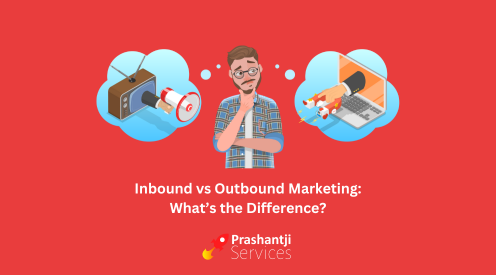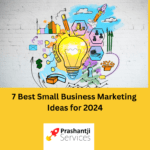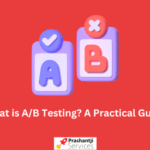Inbound vs Outbound Marketing: What’s the Difference?
In today’s rapidly evolving marketing landscape, understanding the nuances of inbound and outbound marketing is crucial for businesses seeking to capture the attention of an increasingly informed and discerning consumer base.
Modern marketers often face the challenging question of which approach to prioritize, given the deluge of offers, advertisements, and choices bombarding consumers from all angles.
As 78% of consumers turn to the internet for product research, businesses are compelled to take a proactive stance. They can either passively hope their product shines as the best choice,
or they can proactively become the primary source of information that consumers seek. This is the essence of inbound marketing, a strategy that has not only emerged but thrived in response to this changing landscape.
But what exactly distinguishes inbound marketing from the more traditional “outbound” marketing? Inbound vs outbound marketing is not merely a difference in strategy; it often represents a difference in philosophy for businesses.
In this article, we will explore both marketing approaches, their advantages and disadvantages, and what makes each of them unique.
What are Inbound and Outbound Marketing?
Inbound marketing and outbound marketing share a common goal: converting customers. However, they take distinct paths to achieve this goal.
While inbound marketing focuses on nurturing prospects, inviting them in, and providing valuable content along the way, outbound marketing emphasizes spreading awareness, casting a wide net, and reaching out to a larger audience with the aim of turning them into customers.
Inbound Marketing Definition
Inbound marketing, often referred to as content marketing, is a strategy centered around “pulling” customers in through informative and useful content. It prioritizes education and building deeper, more genuine connections with the audience.
Inbound marketing typically involves three stages:
1. Attract
This stage embodies the core difference between inbound and outbound marketing. Instead of aggressively promoting your brand to the masses, inbound marketing is about attracting people to your brand. This is achieved by creating Search Engine Optimized (SEO) content, such as blogs, eBooks, and pillar pages, to organically draw visitors from search engine results pages (SERPs). It can also involve Google ads, social media posts, email campaigns to opt-in lists, and more. The key is that you’re not forcing your brand or products onto anyone; you’re offering value that entices people to engage voluntarily.
2. Engage
Once you have their attention, you can further impress them with valuable content that guides them along the customer journey. In today’s consumer-centric landscape, people conduct their research, make decisions on their own terms, and prefer well-informed choices. This stage focuses on providing the resources individuals need to become informed and realize that your product aligns with their needs.
3. Delight
The final step revolves around turning customers into advocates. It involves providing exceptional experiences that leave customers satisfied, happy, and eager to talk about your company with friends, family, colleagues, or anyone who will listen. Reviews play a significant role, with 94% of customers stating that their purchases are influenced by reviews. Delighted customers are more likely to become valuable repeat customers and advocates for your brand.
Inbound Marketing Examples
- SEO-optimized content, including blogs, eBooks, checklists, and infographics
- Consistent social media posting
- Conversion-focused landing pages
- Email marketing campaigns targeting opt-in lists
- Webinars and other opt-in content to convert prospects
- Referral links from related websites
Pros and Cons of Inbound Marketing
Pros:
- Non-Interruptive: Inbound marketing respects consumers’ time by not interrupting their activities with intrusive ads. It’s an invitation, not a megaphone.
- Highly Targeted: Inbound marketing allows precise targeting of keywords that your ideal customers are actively searching for.
- Long-Term Effectiveness: It continues to work over time and gains momentum, especially as search engines recognize your content.
- Deeply Engaging: Content fosters deeper connections with your audience, making them more likely to become advocates and repeat customers.
Cons:
- Not a Quick Fix: It requires time and consistent effort. SEO-focused strategies, like inbound marketing, demand ongoing content creation and optimization.
- Time-Consuming: Implementing inbound marketing involves managing various elements, including social media, ads, email, content creation, and lead management, which can be time-intensive.
Outbound Marketing Definition
Outbound marketing, often considered “traditional” marketing, involves companies actively reaching out to potential customers through methods like cold calling and advertising.
Instead of waiting for customers to discover them organically, outbound strategies proactively push messages about their products and brand.
Outbound Marketing Examples
- Cold calling or cold emailing
- Direct mail
- Tradeshows or conferences booths
- TV, radio, or print ads
- Sponsorships
- Billboards
Pros and Cons of Outbound Marketing
Pros:
- Faster Turnaround: Outbound strategies are typically quicker to implement, requiring less research and time.
- Large Audiences: They can put your brand or product in front of a vast audience.
Cons:
- Interruptive: Outbound marketing tends to interrupt consumers’ activities, which can have less impact and risk damaging your brand.
- Vague Targets: It’s challenging to pinpoint your audience precisely, leading to less targeted marketing.
- Difficult to Track: Large outbound campaigns can be hard to track, making it challenging to assess their direct impact on your business.
The Difference Between Inbound vs Outbound Marketing
The fundamental distinction between inbound and outbound marketing lies in how you engage your audience. Inbound is about potential customers finding you based on their interests or pain points,
while outbound marketing involves pushing your message in front of them. Inbound is education-focused, fostering deeper connections, while outbound is awareness-focused.
Both approaches have their merits, and the choice between them depends on your goals. However, in the digital age, inbound marketing leverages your understanding of your products and customers, offering a chance to connect with consumers on a deeper level than a traditional billboard by the freeway.
In summary, the choice between inbound and outbound marketing depends on your audience, objectives, and the depth of connection you aim to establish with your customers.
Making Your Choice: Inbound or Outbound Marketing
Choosing between inbound and outbound marketing strategies isn’t a one-size-fits-all decision. Your selection should align with your business goals, target audience, and the depth of connection you wish to establish with your customers.
When to Choose Inbound Marketing
1. Informed Customer Base: Inbound marketing is an excellent choice when your target audience is already well-informed and actively searching for solutions. It allows you to position your brand as a valuable resource that can guide them in their decision-making process.
2. Long-Term Brand Building: If you’re looking to build a brand with a lasting impact, inbound marketing is your ally. Over time, it snowballs, and your library of valuable content grows in influence.
3. Engagement and Connection: If your aim is to create deep, engaging connections with your audience, inbound marketing excels. It’s a tool for building trust and loyalty by consistently delivering value.
4. Conversion and Advocacy: Inbound marketing’s final phase, “Delight,” can turn satisfied customers into advocates who spread the word about your brand, potentially leading to increased sales and brand loyalty.
When to Choose Outbound Marketing
1. Quick Results: If you require swift results, outbound marketing can be a better fit. It often starts working faster and can yield immediate returns on your investment.
2. Large-Scale Awareness: For businesses seeking to reach a vast audience quickly, outbound marketing methods, such as billboards, TV commercials, and mass email campaigns, can be effective in boosting brand awareness.
3. Event Marketing: Outbound marketing is well-suited for promotional events, tradeshows, or conferences where direct engagement with a broader audience is the goal.
4. New Product Launch: When introducing a new product or service, outbound marketing can help you create a significant initial impact.
In conclusion, the choice between inbound and outbound marketing hinges on your specific objectives and the nature of your target audience. For the modern marketer, balancing these strategies can be the key to a successful marketing campaign.
Conclusion
Inbound vs outbound marketing isn’t just a choice of strategies; it’s a reflection of your approach to connecting with your audience. Inbound marketing focuses on nurturing and educating, while outbound marketing aims to spread awareness through proactive outreach.
Ultimately, the decision should be influenced by your business goals, your audience’s behavior, and the depth of engagement you desire. In the digital age, inbound marketing offers a unique opportunity to connect on a deeper level with consumers, fostering lasting relationships and brand loyalty.
As you navigate the complex world of marketing, remember that there’s no one-size-fits-all solution. Inbound and outbound marketing can coexist and complement each other, creating a comprehensive marketing strategy that meets your business’s diverse needs.
So, whether you choose to “pull” your customers in through inbound marketing or actively “push” your message to reach them through outbound marketing, the key is understanding your audience and delivering value in the way that resonates most with them. It’s your connection with your customers that will ultimately set you apart in the ever-evolving world of marketing.
FAQs
- Can I use both inbound and outbound marketing simultaneously?
- Yes, many businesses find success by blending both strategies to reach a broader audience and create a holistic marketing approach.
- Which is more cost-effective, inbound or outbound marketing?
- Inbound marketing is often more cost-effective in the long run, but outbound marketing can yield quicker results in certain situations.
- How can I measure the effectiveness of my inbound marketing efforts?
- Metrics like website traffic, conversion rates, and social media engagement are essential for assessing the success of inbound marketing campaigns.
- Are there specific industries where outbound marketing is more effective?
- Outbound marketing can be effective in industries where brand visibility and quick results are essential, such as retail and entertainment.
- What role does social media play in inbound marketing?
- Social media is a crucial component of inbound marketing, as it allows for direct engagement with your audience and the sharing of valuable content.








